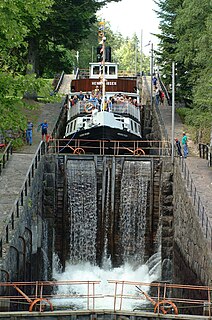 W
WTimber rafting is a method of transporting felled tree trunks by tying them together to make rafts, which are then drifted or pulled downriver, or across a lake or other body of water. It is arguably, after log driving, the second cheapest means of transporting felled timber. Both methods may be referred to as timber floating.
 W
WA raft is any flat structure for support or transportation over water. It is usually of basic design, characterized by the absence of a hull. Although there are cross-over types that blur this definition, rafts are usually kept afloat by using any combination of buoyant materials such as wood, sealed barrels, or inflated air chambers, and are typically not propelled by an engine.
 W
WThe Bingen Booms is a system of log booms on the Glomma River below Sørumsand in the municipality of Sørum, Norway. The first boom system at the site may have already been built in the 14th century, and was certainly in place by the 16th century. At the booms, timber was sorted and bundled before it was driven down the Glomma River and distributed to sawmills on the shore of Lake Øyeren.
 W
WThe Bull-of-the-Woods Logging Scow is a small paddle steamer wrecked in Burntside Lake in Morse Township, Minnesota, United States. It was built no earlier than 1893 for one of the lumber companies operating in the area. It is a small, flat-bottomed vessel outfitted with a steam donkey modified to power the vessel as well as a winch. There were at least a few of these vessels in operation in northeastern Minnesota in the late 19th and early 20th centuries, where they were locally known as "alligators" or "gators". With the steam-powered winch and shallow paddle wheels, they could tow timber rafts, hoist logs, navigate shallow waters, and even pull themselves across dry land. This vessel may have remained in service as late as 1926, when the last lumber company ceased operations on Burntside Lake. It is the only known surviving example of its type.
 W
WThe Fetsund Booms are a Norwegian national cultural heritage monument, log driving museum, and wetland center at the outlet of the Glomma River into Lake Øyeren in Fetsund in Viken county. The Fetsund Booms were set up as a timber sorting facility in 1861 and operated until 1985, when log driving came to an end on the Glomma River. Today the facility is part of the Akershus Museum.
 W
WA log flume is a flume specifically constructed to transport lumber and logs down mountainous terrain to a sawmill by using flowing water. These watertight trough-like channels could be built to span a long distance across chasms and down steep mountain slopes. The use of log flumes facilitated the quick and cheap transportation of logs and thereby eliminated the need for horse- or oxen-drawn carriages on dangerous mountain trails.
 W
WThe Ottawa River timber trade, also known as the Ottawa Valley timber trade or Ottawa River lumber trade, was the nineteenth century production of wood products by Canada on areas of the Ottawa River destined for British and American markets. It was the major industry of the historical colonies of Upper Canada and Lower Canada and it created an entrepreneur known as a lumber baron. The trade in squared timber and later sawed lumber led to population growth and prosperity to communities in the Ottawa Valley, especially the city of Bytown. The product was chiefly red and white pine.The Ottawa River being conveniently located with access via the St. Lawrence River, was a valuable region due to its great pine forests surpassing any others nearby. The industry lasted until around 1900 as both markets and supplies decreased.
 W
WPike poles are long metal-topped wood, aluminum, or fiberglass poles used for reaching, holding, or pulling. They are variously used in construction, logging, rescue and recovery, power line maintenance, and firefighting.
 W
WThe Schüttesäge Museum is a museum in the town of Schiltach in the Black Forest. It is located in the county of Rottweil in the German federal state of Baden-Württemberg. The museum has exhibits on the themes of forestry, tanning and timber rafting in Schiltach and the surrounding area in the Upper Kinzig valley.
 W
WA splash dam was a temporary wooden dam used to raise the water level in streams to float logs downstream to sawmills. By impounding water and allowing it to be released on the log drive's schedule, these dams allowed many more logs to be brought to market than the natural flow of the creek allowed. Water releases from multiple splash dams on tributaries were also often combined to maximize the number of logs floated throughout a given watershed.
 W
WThe Telemark Canal connects Skien to Dalen in southern Norway by linking several long lakes in the Skien watershed through a series of 18 locks.
 W
WTukkilaiskisat (Tukkilaiset) is a traditional timber rafting competition in Finland. Originally tukkilaiset referred to log drivers.